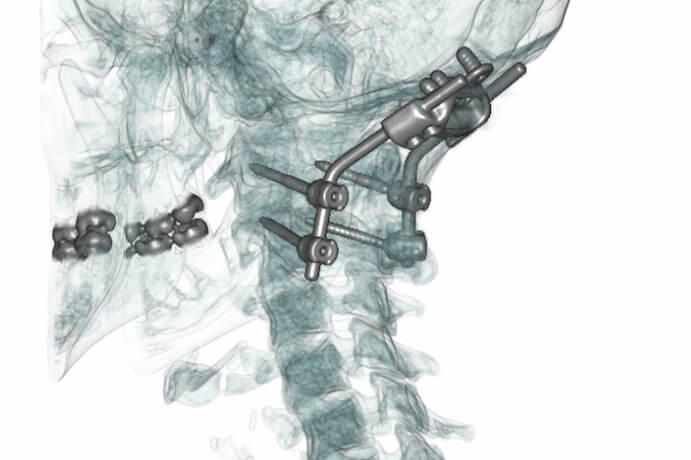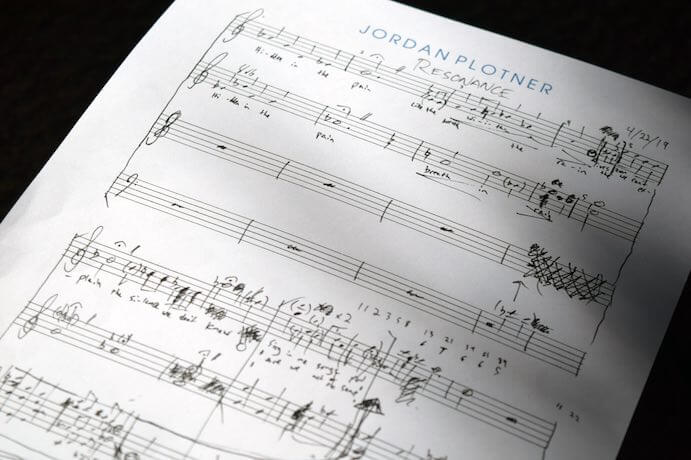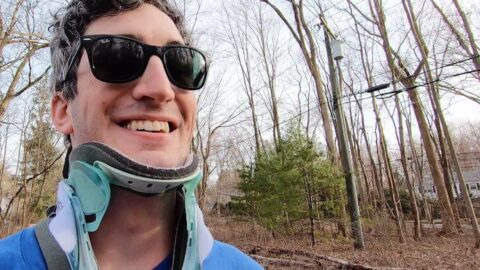Pigeonhole Jordan Plotner at your own risk. His resume includes scores for dozens of films, TV shows, and ad spots, as well as concert music and songs. A polymath, he first earned media attention for 3D-printing a beer-bottle keyboard while majoring in American Studies at Yale. This fall, Plotner is introducing a new project, at once rooted in personal experience and inclusive by design. He lives with Ehlers-Danlos Syndrome, a group of connective-tissue disorders associated with chronic pain and neurological symptoms. His Resonance Project centers on a self-filmed, -produced, and -scored documentary that captures his experiences of surgery and recovery. The film will conclude with a multi-tracked recording of an orchestral-choral piece titled Resonance. Fellow musicians with disabilities can download the sheet music, record their parts, and submit their contribution online. Plotner intends The Resonance Project as a consciousness-raising corrective to the invisibility of artists with pain and mobility issues.
You make some compelling analogies in your descriptions of the project. For instance, you point out how hard it is to hear the overtones of a sound when your ear wants to zero in on the fundamental pitch. Similarly, some still refuse to see or acknowledge the hidden sensations that affect people with seemingly untroubled exteriors. How does The Resonance Project make experiences of life-altering but hidden pain not only visible on film, but also audible in music?
I began writing Resonance one month after surgery on my spine and skull. Above all, I wanted it to be a viscerally enjoyable piece of music. One layer deeper, I wanted the lyrics to simultaneously embody the challenge and elusive reward of searching for meaning in the seemingly random adversities of life:
Hidden in the pain
Like the breath within the rain
Lives the poem we can’t explain
The silence we don’t know.
The layers continue deeper, bridging the gap between the lyrics, music, and concepts at large. In the very heart of the piece live the questions to which I have no answers–questions to which there are no answers! Like mathematician Kurt Gödel’s Incompleteness Theorem that demonstrates the inherent limitations of any formal system (even our trustworthy system of numbers!), or Elisha Ben Abuyah’s fruitless quest in the 2nd century to prove the existence of God using only Euclidean logic (as depicted in Milton Steinberg’s “As A Driven Leaf”), my piece, Resonance, at its core seeks to examine the Unknown upon which our conceived notions of order are built. It is this thrilling pursuit of answers to these great existential puzzles that will forever keep me writing.
You live with a set of conditions that medicine terms disorders, yet you note that you intentionally wrote music based on a sort of underlying order–Resonance contains a musical reference to the numbers of the Fibonacci sequence, for instance. Why do you feel so drawn to this sort of deeper pattern, especially in this context?
For 24 years, my Ehlers-Danlos Syndrome (EDS) was undiagnosed. Yet during those last four years–when the mysterious _______ seemed to be consuming my health, my mind, my energy–I would not have said that I was sick, ill, or disabled. Was I, in fact, those things? Yes. Words are a funny thing. Though they act as a liaison between (in this case) the individual and the outside world, they themselves are hollow, filled only with the meanings we give them. ‘Disorder’ implies an absolute lack of order, a notion I find deceiving. For I strongly believe that, like most disorders, EDS is inherently orderly, just defined by patterns which we do not yet understand.
In 16th century Greece, the words ‘sun’ (‘together’) and ‘dramein’ (‘to run’) were combined to form ‘syndromos,’ defined as a place where several roads meet. From ‘syndromos’ we eventually arrived at ‘syndrome.’ It is the complex tapestry of interwoven symptoms that link our modern definition to its elemental Grecian roots.
Before putting pen to paper, I wanted to ensure that I had a clear conceptual structure of the piece in my head. How would the lyrics and music develop individually, and together? In the second ‘section’ of the piece, there is a shift in voice and a new melodic theme is introduced:
Do not fear me stranger
No you are not to blame
And I am just a part of you
A gene in a name
This is the voice of the ‘syndrome’–a gene–addressing its ‘host.’ I wanted to describe the idea that this gene (which manifests in me as EDS) has lived for centuries in the genetic code of my ancestors, and that I exist because of those that came before me. So how to depict such a concept… An infinite pattern, perhaps? The Fibonacci Sequence!
In the sequence, every number is the sum of the two numbers that precede it (1, 1, 2, 3, 5, 8…). If we were to assign number values to every note in the F major scale we have F(1), G(2), A(3), Bb(4), C(5), D(6), E(7), F(8)… So what would be the note values of the first, say, eleven number of the Fibonacci Sequence? F(1), F(1), G(2), A(3), C(5), F(8), D(13), E(21), D(34), D(55), C(89). These became the first two melodic phrases of the ‘gene theme.’ The concept is further reinforced as these four lines are played as a two-part fugue. (Also notice the first letter in each of the first three lines of the above verse…) These are just some examples of how I integrated patterns into the music and lyrics in order to develop the piece conceptually.

Composers and institutions have convened virtual and web-based ensembles before, often with plenty of publicity but few stated goals beyond “bringing people together” and experimenting with new media. What distinguishes this project, in terms of both objectives and execution?
With EDS, the struggle to live independently can be not just a lonely existence, but also an inherently paradoxical one. In proving to myself that I can live self-sufficiently, free of the pressures felt by burdening another, I, in turn, am led to push people away. In pushing people away, I am left alone, forced to realize that I cannot singlehandedly fulfill that most fundamental human emotion of being part of a community.
In the four years prior to my diagnosis, I’d declined hundreds of invitations from friends to hang out, or grab coffee because I was physically unable. Though the pain left me feeling badly, the act of constantly saying ‘no’ to people I loved left me feeling worse, for I knew I was pushing them away, driving an undiagnosed wedge between us.
For many with chronic illness, online communities fill such a void, and deliver the necessary fulfillment. There is, after all, no physical barrier to entry. But what about those voids not so easily filled by your typical online community? Like the rush of energy–that multisensory euphoria!–of playing in an orchestra or band. Music, like any language, derives its greatest power in the spaces between the people it brings together. I wanted to create an ensemble designed for those musicians whose inability to make long-term physical commitments ordinarily precludes their participation in more traditional ensembles.
The Resonance Project is a more conceptually specific iteration of Whitacre’s virtual choir, and includes traditional orchestral instruments as well as custom instruments designed specifically for disabled players. In terms of execution of The Resonance Project, I will have to get back to you with an answer when it’s all finished!

As someone who teaches music history, I sometimes struggle to redirect my students when they endorse the idea that an artist needs to overcome disease or disability to become great. Beethoven is the ultimate example, but it can apply to dozens of musicians past and present, from Schubert and Robert Schumann to Ravel and Lili Boulanger, even Stevie Wonder. Do you find yourself up against misconceptions about the relationship between your condition and your creative life?
It has been just about a year since my diagnosis–not much time to process, especially considering that such processing is not just focused on the present and the future, but also involves making sense of the past through a new lens.
As a 13-year old, it would have been far more likely for me to play baseball in college than it would have been for me to play bass! And then EDS appeared. In 9th grade, I had to stop playing soccer and basketball after continuous knee subluxations, and had to stop pitching in baseball when my hyper-extending elbow evolved from the secret behind my unhittable two-seam fastball to the relentless pincher of my ulnar nerve. It was at this point that I began taking music seriously: guitar and double bass. Without EDS, would I have ever really gotten into music? Likely not.
Of all the seemingly neutral idioms in the English language, I believe “on the right track” to be one of the most harmful. We’ve heard it enough times to ground our notions of progress and development in two dimensions, deeming anything that strays from this vector as a deviation. A train on the right track = good. A train off the tracks (off the rails!) = bad. As a freelance composer, compulsively productive to a fault, the knowledge that I’ll likely have health challenges for the rest of my life leads me towards the trap of wondering, “how much more I could create, accomplish, and experience if I didn’t have to deal with such medical detours…” But what if we thought differently about progress and life trajectories in general? On my post-surgery walks, I grew fascinated with the fractal growth patterns of trees (i.e. how their branches and sub-branches resemble miniature versions of the tree itself). Each tree grows according to a distinctive pattern, in spite of external forces. So, if some sort of fractal algorithm governs the growth of a tree, could there be a corollary in the lives of us humans and the obstacles we encounter as individuals? Even with our free will? I believe so. To find out more, you will have to wait or the release of The Resonance Project documentary!
If you could give every musician with a disability, chronic pain, and/or mobility issues two primary reasons to visit your site and participate in the project tomorrow, what would they be?
- Try looking at/listening to your pain in a new way.
- You and your voice have the power to inspire.
To learn more about participating in The Resonance Project, visit Jordan Plotner’s website.
























